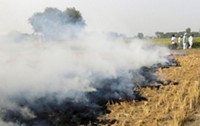Advertisement
Grab your lab coat. Let's get started
Welcome!
Welcome!
Create an account below to get 6 C&EN articles per month, receive newsletters and more - all free.
It seems this is your first time logging in online. Please enter the following information to continue.
As an ACS member you automatically get access to this site. All we need is few more details to create your reading experience.
Not you? Sign in with a different account.
Not you? Sign in with a different account.
ERROR 1
ERROR 1
ERROR 2
ERROR 2
ERROR 2
ERROR 2
ERROR 2
Password and Confirm password must match.
If you have an ACS member number, please enter it here so we can link this account to your membership. (optional)
ERROR 2
ACS values your privacy. By submitting your information, you are gaining access to C&EN and subscribing to our weekly newsletter. We use the information you provide to make your reading experience better, and we will never sell your data to third party members.
Agriculture
Movers And Shakers
Ashok Kumar Singh on making farming in India more sustainable and improving air quality
The director of the Indian Agricultural Research Institute discusses the quest to solve India’s straw waste–burning problem
by Dalmeet Singh Chawla, special to C&EN
March 22, 2022
| A version of this story appeared in
Volume 100, Issue 11

In November 2021, India’s megacity of Delhi introduced lockdown-like measures for something other than the pandemic: air pollution. The toxic haze that covered the country’s capital came mostly from the northern states of Punjab and Haryana, where farmers burn an estimated 23 million metric tons of straw waste from rice harvests every year.
Vitals
▸ Hometown: Born into a farmer’s family in Uttar Pradesh, India
▸ Education: PhD, genetics and plant breeding, Indian Agricultural Research Institute
▸ Best advice he’s received: Believe in your strength; do not depend on others.
▸ Hobbies: Listening to poetry
▸ Most intriguing research project: Development of climate-resilient basmati rice varieties
▸ The crop he thinks is most versatile: Rice. “It can grow from 2 m below to 2,000 m above mean sea level in diverse ecosystems. ‘Rice is life.’ ”
For the farmers, it’s the quickest way to clear the soil for the next crop. But the practice releases high amounts of airborne particulate matter, which threatens the respiratory health of farmers and residents across northern India and degrades the quality of the soil.
Researchers at the Indian Agricultural Research Institute (IARI), also known as the Pusa Institute, think they’ve discovered the solution to this thorny issue—a sprayable biological decomposer that not only consumes the straw waste but also preserves the area’s declining soil health. Some farmers have already begun using it, and the Delhi state government is spraying farmers’ fields with the biodecomposer for free.
Dalmeet Singh Chawla talked to IARI director Ashok Kumar Singh about the recent developments in India’s agricultural practices. This interview was edited for length and clarity.
Why do farmers resort to burning in the first place?
When farmers harvest varieties of rice that take 150 days to mature, that leaves them little time to manage the stubble left behind after harvest and thus less time to clear the field for the next crop.
Most of the burning takes place between Nov. 1 and 15. Around this time, the farmer has to switch from rice harvesting to wheat sowing immediately. If the farmer doesn’t sow the wheat before Nov. 20, there will be a substantial decline in the wheat yield.
But stubble burning has been a major issue from the points of view of human health, soil health, and the environment. Therefore, IARI has been developing new technology for the last 6–7 years, and we launched the biodecomposer in the last couple of years.
Can you tell me a little bit more about the decomposer? What have the initial studies shown that it can do?
The Pusa decomposer is a consortium of seven fungal species. They were selected because they have the ability to biodegrade paddy straw by breaking down cellulose, pectins, and so on using certain enzymes produced by the fungal species.
The usual procedure is that these fungal species are provided in the form of a capsule. In the preparation procedure, four capsules are diluted in 25 L of water, which is enough to spray 1 hectare of land. It takes around 25 days to decompose the paddy straw and prepare the field for wheat sowing.
In 2021, we upped the scale with the help of certain partners in the industry. The decomposer was used on 100,000 ha of land in Punjab, 100,000 ha in Haryana, and around 360,000 ha in western Uttar Pradesh.
What kinds of health and ecological benefits do farmers get from using the decomposer as opposed to burning?
Health-wise, if you burn straw in your field, the first person who gets affected is you, because it is happening in your vicinity. After that, the smoke and smog are going to other people who are close to you.
When farmers burn paddy straw, the temperature of the soil surface rises, and because of that higher temperature, the microbial population in the soil also gets destroyed. Soil is one of the biggest living entities; it harbors a large number of microbes, and many of them are very beneficial to plants.
Another benefit of using the decomposer is that the decomposition process enriches the soil with organic carbon, which has been declining in soil in different Indian states over the years. It’s around 0.4–0.5% when, for optimal soil health, it should be around 0.8%.
Our ultimate goal is to introduce these practices as a part of a regenerative agricultural project.
What are IARI and the Indian government doing to get farmers to switch to these regenerative practices?
Our advice would be that farmers understand the benefits of soil health for long-term sustainability of the production system. In that context, incorporation of paddy straw into soil with a decomposer to enhance the organic carbon and microbial health of the soil is extremely important.
Also, if a farmer is using the decomposer and not burning his straw—thus mitigating the greenhouse gas emissions—then they should get incentives. Therefore, this will turn into a form of what is called carbon farming. If a farmer gets one carbon credit for 1 ha, for example, he can get about 1,500–1,600 rupees ($19–$21) per hectare as an incentive. In due course, carbon farming will be the order of day.
Our initial data show that using the decomposer does not increase overall carbon dioxide emissions when compared with natural decomposition. We are still collecting data on the effect of the decomposer on nitrous oxide and methane emissions, but we have some indication that there is actually a reduction in those emissions.
Apart from the decomposer and burning, are there other techniques farmers can use to dispose of their paddy straw?
If farmers wish to grow long-duration varieties, which typically have higher yields than shorter-duration options, other methods are to use mechanical devices that are mounted on tractors that sow wheat into the soil and cut and lift rice straw, depositing it as mulch.
Another mechanical approach is using bailing machines to extract paddy straw and pack it into rectangular-shaped stacks that can then be used at biomass plants to generate electricity. There are now 18 plants in Punjab that use paddy straw power generation.
No single solution will be enough. We have to use multiple approaches.
Do you think stubble burning has been politicized? And do you think that’s going to be a barrier in resolving this problem?
Well, we are scientists, and we don’t get involved with any kind of politics. I must say that science is very fair in its approach. And governments have rolled out mitigation strategies and invested significant amounts of money in resolving the problem.
Farmers also understand the demerits of burning. They don’t want to burn, but they need to have solutions.
Dalmeet Singh Chawla is a freelance science journalist based in London. A version of this story first appeared in ACS Central Science: cenm.ag/ashok.




Join the conversation
Contact the reporter
Submit a Letter to the Editor for publication
Engage with us on Twitter